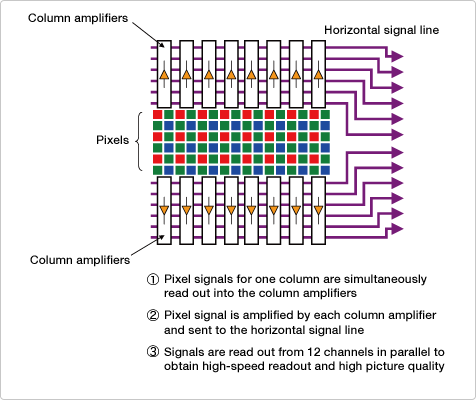Nikon FX-format CMOS Sensor
Fig. 1: Nikon DX and FX formats
At the heart of every digital camera is an image sensor that gathers the light which comes through the lens. Photodiodes integrated in the sensor convert the light to electrical signals for image processing, and the resulting data is saved in the camera’s memory card. In this process, the key points that determine the quality of image are how much light can be loaded as an electric charge to each of the pixels composing the image sensor and how efficiently that light can be converted to an electrical signal.
Nikon has developed a variety of superb image sensors for digital cameras — including the CCD, LBCAST and CMOS sensor — since the DX-format image sensor of the digital SLR Camera Nikon D1, released in 1999. The Nikon FX-format CMOS image sensor introduced here is our answer to professional photographers’ needs for extra-high sensitivity and image quality.
The foremost factor distinguishing the Nikon FX format from other image sensors is the larger pixel size, which allows it to collect more light. The D3 features 12.1 effective megapixels, with a pixel size of 8.45 x 8.45µm — 2.4 times larger than the pixels of the DX format image sensor used in the D2X camera.The actual size of the D3’s CMOS sensor is approx. 36.0 x 23.9mm — more than twice as large. Larger pixels can collect more light. Furthermore, the photodiode design has been revised. The photodiode is normally surrounded by a layer of electrical wiring. If this wiring layer is thick, it may obstruct the light before it reaches the photodiode. So when designing the opening of the photodiode where the light is received, it is important to minimize the size of the wiring layer as much as possible.
Fig. 2: Gapless on-chip lens
Efficiently guiding the light to the photodiode to increase the light harvest is another vital factor. As shown in the illustration (Fig. 2) of the image sensor cross-section, the sensor surface is equipped with microlenses, with a small gap between them. The light, having passed through this gap, is reflected by the wiring layer, and does not reach the photodiode. To solve this problem, Nikon employed an on-chip lens that eliminates the gap. By specially engineering the curvature of the lens, light passing through the corner of the lens is able to reach the photodiode without obstruction. Furthermore, the materials employed for the paths that the light follows have been improved so that the light reaches its destination without attenuation. The wiring layer, which has been miniaturized to make the photodiode’s opening as large as possible, has been flattened to reduce the distance between it and the photodiode. Yet another insightful Nikon idea to improve the light-gathering rate.
Much of the light collected in the photodiode is converted to electrical signals. When high-ISO sensitivity is selected, however, the electrical signal is often so faint that it cannot be used without amplification. Minimizing the noise generated during amplification is vital to obtaining high-quality images.
At Nikon, the amplification circuit is integrated into the image sensor. Since amplification is performed near the area generating an electrical signal, it is difficult for noise from other areas to enter the amplified signal. This enables the degree of amplification at the final-stage amplifier to be lowered.
Nikon has also developed an original method for reading the amplified electrical signal — 12-channel high-speed readout. By reading electrical signals in parallel, high-speed readouts are achieved (about twice the speed of the D2X). At the same time, the drive speed for a single channel becomes inversely lower. This results in better suppression of noise generated in the circuit, and realizes such sophisticated functions as high-speed continuous shooting at approx. 9 frames per second (for 12.1-megapixel images), Live View shooting and Contrast-detect AF while maintaining superior image quality.

Fig. 3: 12-channel high-speed readout
Nikon offers an increasingly versatile digital camera lineup to meet a diverse range of needs and applications, and the image sensor can be an important factor in camera selection. DX format, for example, is more suitable for photographers requiring a mix of mobility, operability and image quality. FX format, on the other hand, is ideal for those seeking the same picture angle and picture blur as 35mm (135) format cameras, with higher sensitivity and wider dynamic range. Nikon continues to make rapid progress in developing sensors and related technology that meet the needs of the world’s most demanding photographers.
Posted June 2008
